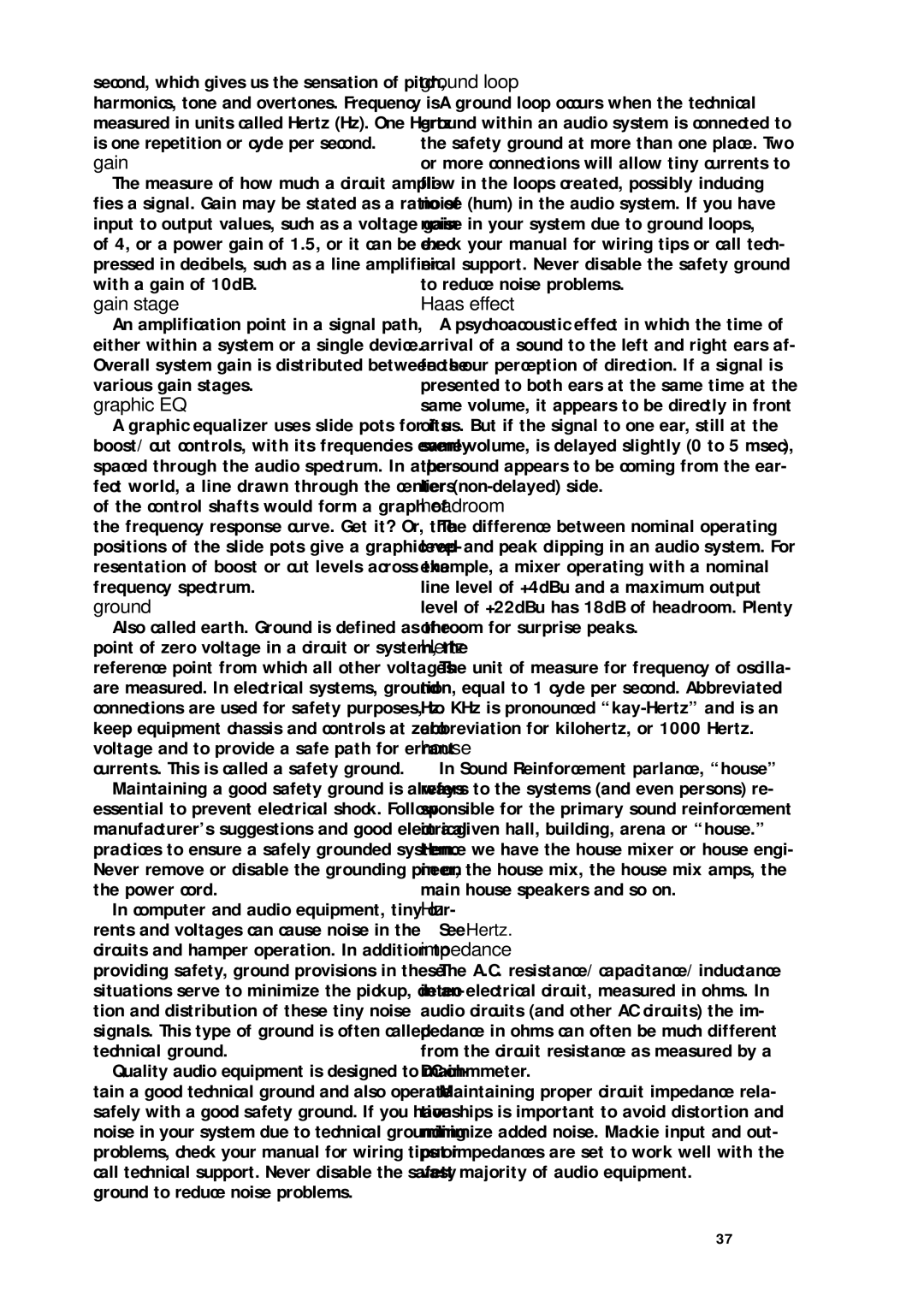second, which gives us the sensation of pitch, harmonics, tone and overtones. Frequency is measured in units called Hertz (Hz). One Hertz is one repetition or cycle per second.
gain
The measure of how much a circuit ampli- fies a signal. Gain may be stated as a ratio of input to output values, such as a voltage gain of 4, or a power gain of 1.5, or it can be ex- pressed in decibels, such as a line amplifier with a gain of 10dB.
gain stage
An amplification point in a signal path, either within a system or a single device. Overall system gain is distributed between the various gain stages.
graphic EQ
A graphic equalizer uses slide pots for its boost/cut controls, with its frequencies evenly spaced through the audio spectrum. In a per- fect world, a line drawn through the centers of the control shafts would form a graph of the frequency response curve. Get it? Or, the positions of the slide pots give a graphic rep- resentation of boost or cut levels across the frequency spectrum.
ground
Also called earth. Ground is defined as the point of zero voltage in a circuit or system, the reference point from which all other voltages are measured. In electrical systems, ground connections are used for safety purposes, to keep equipment chassis and controls at zero voltage and to provide a safe path for errant currents. This is called a safety ground.
Maintaining a good safety ground is always essential to prevent electrical shock. Follow manufacturer’s suggestions and good electrical practices to ensure a safely grounded system. Never remove or disable the grounding pin on the power cord.
In computer and audio equipment, tiny cur- rents and voltages can cause noise in the circuits and hamper operation. In addition to providing safety, ground provisions in these situations serve to minimize the pickup, detec- tion and distribution of these tiny noise signals. This type of ground is often called technical ground.
Quality audio equipment is designed to main- tain a good technical ground and also operate safely with a good safety ground. If you have noise in your system due to technical grounding problems, check your manual for wiring tips or call technical support. Never disable the safety ground to reduce noise problems.
ground loop
A ground loop occurs when the technical
ground within an audio system is connected to the safety ground at more than one place. Two or more connections will allow tiny currents to flow in the loops created, possibly inducing noise (hum) in the audio system. If you have noise in your system due to ground loops, check your manual for wiring tips or call tech- nical support. Never disable the safety ground to reduce noise problems.
Haas effect
A psychoacoustic effect in which the time of arrival of a sound to the left and right ears af- fects our perception of direction. If a signal is presented to both ears at the same time at the same volume, it appears to be directly in front of us. But if the signal to one ear, still at the same volume, is delayed slightly (0 to 5 msec), the sound appears to be coming from the ear- lier
headroom
The difference between nominal operating level and peak clipping in an audio system. For example, a mixer operating with a nominal line level of +4dBu and a maximum output level of +22dBu has 18dB of headroom. Plenty of room for surprise peaks.
Hertz
The unit of measure for frequency of oscilla- tion, equal to 1 cycle per second. Abbreviated Hz. KHz is pronounced
house
In Sound Reinforcement parlance, “house” refers to the systems (and even persons) re- sponsible for the primary sound reinforcement in a given hall, building, arena or “house.” Hence we have the house mixer or house engi- neer, the house mix, the house mix amps, the main house speakers and so on.
Hz
See Hertz.
impedance
The A.C. resistance/capacitance/inductance in an electrical circuit, measured in ohms. In audio circuits (and other AC circuits) the im- pedance in ohms can often be much different from the circuit resistance as measured by a DC ohmmeter.
Maintaining proper circuit impedance rela- tionships is important to avoid distortion and minimize added noise. Mackie input and out- put impedances are set to work well with the vast majority of audio equipment.
37
